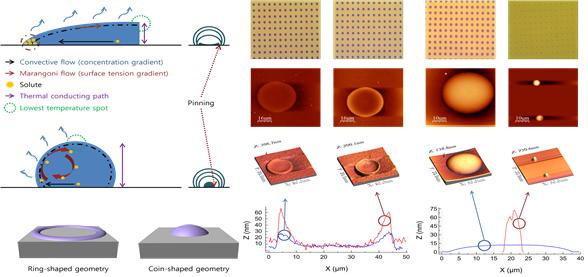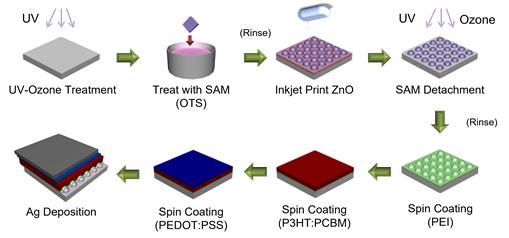Implementation of an Inkjet Print-Based Ultra-Small Zinc Oxide Microdot Array (Possible for Nanoprinting Technology)
- 글번호
- 392557
- 작성일
- 2024-08-13
- 수정일
- 2024-08-13
- 작성자
- 홍보팀 (032-835-9490)
- 조회수
- 3391
_김경식(인천대학교_지능형반도체공학과_석사과정).jpg)
Lee Jin-ho (an assistant professor of physics at Incheon National University) and Kim Kyung-sik (a master's course in the department of intelligent semiconductor engineering at Incheon National University)
Professor Lee Jin-ho of the Department of Physics at Incheon National University (President Park Jong-tae) succeeded in implementing the world's smallest 3-μm diameter zinc oxide microdot array without a separate lithographic process using inkjet printing technology.
The research team analyzed the correlation between the internal microfluidic behavior and the solidification mechanism according to the geometry of inkjet-printed droplets.
Inside the droplet with a small contact angle, convective flow in the outside direction prevails, resulting in a strong coffee ring effect after coagulation, while in the case of a droplet with a large contact angle, the Marangoni flow circulating inside is strengthened, delaying the fixing of the contact line of the droplet during the drying process and forming a miniaturized microdot structure with a suppressed coffee ring effect.
The research team implemented a micronized zinc oxide microdot array by minimizing the initial contact area of the droplets by controlling the surface energy and temperature of the substrate and applied it to organic solar cells.
It was confirmed that the absorption of the solar cell in the photoactive layer was increased by the optical effect of the microdot array, thereby improving the efficiency.
Professor Lee Jin-ho, who led the study, said, "This study could not only suppress the coffee ring effect, which is an obstacle to inkjet printing, but also implement a much smaller micro-dot structure compared to early droplets." "If inkjet printing technology develops, it is expected that nano-sized structures will be easily implemented through the printing process and applied to various optical devices."
This study was conducted with Dr. Hong-gyu Kang of Gwangju Institute of Science and Technology and Dr. Soon-il Hong of the Korea Institute of Chemical Research and Technology, and was published in the Journal of Materials Research and Technology (JCR Top 6.1%), an international journal in the field of materials and metal engineering.

The internal microfluidic behavior of inkjet printed droplets and the geometry of solidified microdots.

A schematic diagram of an organic solar cell manufacturing process including a zinc oxide microdot array.